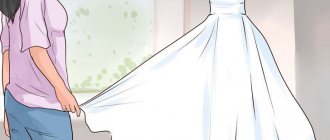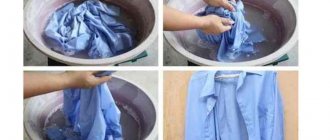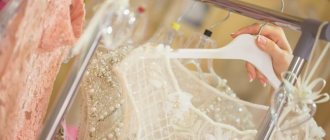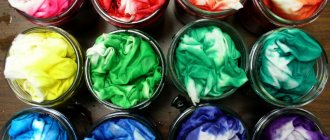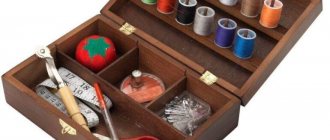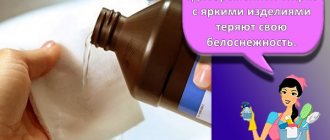Starched items look beautiful and are pleasant to the body. Therefore, housewives starch them after washing. More information about how to starch laundry will be discussed in this article.
What is starch used for?
As a result of treatment with a starch solution, the fabric fibers are impregnated with polysaccharides. A thin film is formed on the surface of the material, thanks to which:
- the density of the fabric increases, the product retains its shape better and does not wrinkle;
- light-colored items are bleached and look snow-white;
- clothes remain clean for a long time, as the film repels dirt from the fabric;
- During subsequent washing, the stains are washed off more easily.
Attention! Only clean, washed, stain-free clothes should be starched.
The simplest and most affordable option is to use potato starch. You can also use corn, rice, wheat.
Using the machine
You can starch a dress not only by hand, but also using a washing machine. Pour the paste into the conditioner compartment and turn on the washing mode appropriate for the fabric. The inconvenience is that some of the solution may remain in the machine. To rinse your washer, turn it on the rinse cycle after removing the dress, then thoroughly wipe the drum.
For machine starching of products, special gels and powders containing starch are sold. It is more convenient to work with them.
Starching a dress is not as difficult as it seems at first. Use these recommendations and you will look irresistible.
What products cannot be starched?
Not every item can be treated with starch. Here are some products that are not suitable for this:
- Underwear, since starched fabric is poorly breathable and does not allow the skin to breathe. In addition, hard items of underwear can rub the skin and cause discomfort.
- Summer open clothes. A person should feel comfortable in hot weather; starch will make the fabric too dense. A good idea is to starch only certain details, for example, a collar or frills on a sundress.
- Black items - cloudy stains will appear, you will have to wash the clothes again.
- Synthetic fabrics, it is useless to starch them, the item will remain just as soft.
- Embroidery made using floss. The concentrated solution will stick the threads together and the work will look sloppy. To starch embroidery, alternative methods are used.
The nuances of starching fabrics of different types
- If you want to starch cotton and linen items, this can be done using traditional methods.
- Chiffon items need to be starched with weak solutions. A similar mixture is used to work with organza. This material can also be treated with a gelatin solution.
- To starch lace, a medium starch or glue solution is suitable. To work with tulle, use the same solution.
Now you know how to dilute starch and how to starch things correctly. There is nothing difficult about this if you follow all the tips.
In what concentration should you dilute starch?
Starch should be diluted strictly in certain proportions. It all depends on the final goal: it is necessary to ensure that the fabric is slightly compacted or clearly holds the required shape.
Weak solution
A weak concentration of starch solution helps to slightly whiten the product, making it more elastic and resistant to creasing. This is how you can starch:
- women's blouses;
- Men's shirts;
- children's clothing for special occasions;
- decorative pillowcases;
- uniform for employees of medical institutions.
Attention! Colored items are starched with a weak solution so as not to damage the color of the fabric. You should make sure in advance that the product does not fade.
For 1 liter of water you will need to take 1 tsp. starch. You should focus on the volume of things that need to be starched. For example, for 2-3 men's shirts, 5 liters will be enough. For this volume you will need 5 tsp. starch. An important condition is that the starch should not form lumps.
Step-by-step instruction:
- Stir the powder in a glass of water at a temperature of 27-30°C, break up all the formed lumps;
- bring the required volume of water to a boil;
- pour in the prepared mixture, mix well and remove from heat;
- after cooling, immerse things for 2-5 minutes;
After such starching, the product must be carefully straightened and hung to dry, eliminating creases in the fabric as much as possible. It is better to hang shirts, blouses and dresses on hangers.
Advice! You can also starch clothes using a spray bottle. Spray the dried items with starch solution and iron immediately.
Medium solution
You need to starch the fabric in this way in the following proportions: 1 tbsp. l starch per 1 l water. This recipe can be processed:
- tablecloth;
- school apron;
- chef's or doctor's robe.
How to brew starch correctly:
- stir the required amount of powder in 500 ml of liquid;
- pour the resulting mixture into boiling water;
- After cooling, immerse the items in the liquid and starch them for 10-15 minutes.
Advice! To give white things extra shine, add 1 tsp to the prepared mixture. table salt.
Hard solution
The concentrated solution can be used to starch collars, shirt cuffs, rigid tulle petticoats for fluffy dresses, and catering workers' caps. This method is also used to stiffen decorative items, such as fabric flowers. You can starch openwork summer boots with a concentrated solution so that their tops keep their shape well. You will need the following ingredients:
- 50-60 g of starch per 1 liter of water;
- 1 tsp. Boers.
Borax powder can be purchased at a pharmacy.
You need to starch things the hard way in the following order:
- dilute the required amount of starch in 500 ml of water t 20-25 C;
- Dilute borax in 250 ml of water t 38-40C;
- boil the required volume of liquid, add diluted starch, pour in a borax solution;
- mix everything thoroughly, wait 2 hours;
- Soak things in the cooled mixture and leave for 30-40 minutes;
- squeeze, straighten and dry.
Advice! The solution in a strong concentration can be applied with a wide brush.
You can also starch things in the washing machine. To do this, diluted starch must be poured into the conditioner compartment. After washing, it will be added to the final rinse water. Alternatively, wash the items by hand, load them into the washing machine and run the rinse cycle.
Basic Rules
Starching fabric at home is not difficult, let’s figure out how to do it correctly.
Basic Rules:
- Only clean clothes can be processed; as a rule, they are starched immediately after washing;
- for processing it is better to use corn starch, but you can also use potato starch;
- Depending on the type of fabric and the tasks at hand, the concentration of the starch solution is selected. There are three options - weak, medium, concentrated.
The procedure can be carried out either manually or in an automatic machine. When working manually, you need to make a solution and immerse the item completely in it for a short time. Then the item is removed, gently wrung out, straightened and dried.
If you plan to carry out the procedure in a car, then the prepared starch solution must be poured into the compartment intended for the air conditioner. After completing the cycle, be sure to rinse the tray to remove any remaining starch.
You can cook not only the whole thing, but also its individual parts. For example, for men's shirts, only the collar and cuffs can be starched. This can only be done manually.
How to starch a crocheted napkin?
Lace napkins are knitted from cotton threads of different thicknesses. Regardless of the quality of work and the complexity of the pattern, such a product easily wrinkles and loses its shape, especially after washing. To give knitting an aesthetic appearance and whiten it, it is treated with starch. You can starch openwork napkins with a solution of medium concentration.
Procedure:
- 1 tbsp. l. dissolve potato or any other starch in 1 tbsp. water at room temperature;
- add boiling water (700-800 ml) to the starch mixture in small portions and stir until the mixture becomes transparent;
- cool to a temperature of 35-40°C;
- immerse the napkin and leave for 15-20 minutes;
- squeeze, straighten and place on a flat surface.
Lace napkins must be ironed wet, through gauze. The temperature of the iron is set based on the type of thread.
Advice! Knitted baskets, flowers and other non-flat objects need to be starched with a strong concentration solution: 3 tbsp. l. per liter of water.
How to starch a dress or skirt?
A child's or adult's dress should be starched so that the fabric becomes denser, but does not become stiff. To do this, prepare a soft solution. Here's how to proceed:
- remove stains, wash the dress, rinse well;
- dilute 1 tbsp in a glass of water without any residue. l. starch;
- pour the prepared mixture into 2 liters of boiling water, stir well;
- when the mixture has cooled, put the dress in it for 5 minutes;
- Gently wring out the item, straighten it, and hang it on a hanger.
- dry at room temperature or air dry, avoiding direct sunlight;
- After drying, iron through a layer of gauze.
If you need to starch a tulle skirt, hard concentration will come in handy. Procedure:
- Mix 20 g of powder in 200 ml of water;
- Pour the resulting mixture into 1 liter of boiling water, making sure that no lumps form;
- Cool the solution and soak the skirt in it for 7-10 minutes.
The same method is used to process a mesh petticoat. This way you can add additional fluffiness to a child’s dress.
How to starch a shirt?
A starched shirt does not wrinkle for a long time, gets dirty less and looks snow-white. It is important to calculate the required volume of liquid based on the number of shirts. For 2-3 things, 5 liters of water will be enough. How to properly starch a men's shirt:
- wash the shirt by hand or in a machine, remove stains, bleach if necessary;
- 2 tbsp. l. dissolve the powder in a glass of water;
- Boil 2 liters of water in a separate bowl, pour in the concentrate, stir and leave the mixture to cool;
- soak the washed shirt for 15 minutes;
- gently squeeze, avoiding twisting the product;
- dry by hanging on hangers.
Advice! It is important not to overdry the fabric, then ironing it will be much easier.
Step-by-step instruction
Before you start starching a dress or skirt, a preliminary preparation of the product is carried out, consisting of three stages.
- External inspection of the product. Check your clothes for dirt and stains, and mark areas that need to be washed especially thoroughly.
- Removing stains. If there are stains on the dress, then you can remove them using traditional methods: soda, ammonia, hydrogen peroxide, laundry soap.
- Wash. Assess the condition of the item of clothing for contamination. If the dress is clean, then you can start starching, otherwise wash it by hand or in a washing machine.
After this, you can begin the process of starching the dress.
- Prepare the paste. This can be done in two ways: pour the required amount of starch with a small amount of cold water, and then pour the resulting mass into boiling water. You can also add white powder to cold water and bring to a boil over low heat. If the solution looks cloudy, boil it and cool.
- Immerse the dress in the solution. It is enough to hold it for 30 minutes, while the clothes need to be turned over.
- No need to rinse. Wring out the item of clothing carefully to prevent wrinkles from forming, and it is better to allow the solution to drain.
- Hang the dress on hangers. There should be no source of fire nearby.
- Iron when damp. If the item dries out, it will be difficult to iron it.
The knitted product must be carefully laid out; on the hanger it will stretch out and lose its shape.
To speed up the process, you can buy ready-made sprays in the store. They are very convenient to use. The products are especially suitable for items with embroidery, as well as those decorated with beads and rhinestones. It is enough to apply the product to a piece of clothing by spraying and ironing, and the result will not be long in coming.
How to starch individual parts and small things?
To starch a bow, chef's hat, or other small wardrobe item, you should prepare a concentrated solution.
- Dissolve 60-70 g of powder in 200 ml of water;
- pour the mixture into 0.5 liters of boiling water;
When the liquid has cooled, you will need to starch things in it for 15-20 minutes. After this, they are carefully squeezed out and given the desired shape. Once dry, the fabric will become stiff. To starch shirt cuffs or collar, you will also need a concentrated mixture. Individual items of clothing are not soaked in liquid, but treated with a brush. When the starched collar dries, iron it several times with a hot iron.
Advice! You can make your own starch spray: pour the cooled mixture into a spray bottle and spray it liberally onto the fabric.
Ready-made solutions for ironing and starching in aerosols
You don’t have to prepare the solutions yourself, but buy ready-made ironing products in aerosols. Such products are sold in hardware departments. For example, you can use:
- Reinex. Ironing agent in aerosol packaging.
- Sano Iron Starch. A liquid that can be used to spray items before ironing, or poured into the water compartment of a steam iron.
- Top Cleaner. Aerosol product for treating shirt collars and cuffs.
- Satin. The product is in the form of a spray, used when ironing clothes. Convenient to use when ironing dry bed linen.
It’s easy to use ready-made products. The item is processed immediately before ironing. You can process both the entire thing and its individual parts. For example, a flounce on a skirt or a collar on a shirt.
How to starch large items: bed linen or curtains?
Starch helps bed linen not wrinkle and stay clean for a long time. To prevent sheets and duvet covers from being too hard, they should be treated with a weak solution prepared in a proportion of 1 tsp. for 1 liter of water.
Attention! Only freshly washed bed linen can be starched.
It is necessary to calculate how much liquid is needed for soaking, based on this, prepare a starch paste. For 10 liters you will need 10 tsp. starch, stir it in a glass of water and pour this mixture into boiling water. When it cools down, soak the laundry in it for 10 minutes. When drying, sheets and duvet covers must be straightened out well, otherwise they will be difficult to iron. It is easy to starch curtains in the same proportions. They are hung on windows wet so that the fabric straightens under its own weight.
Advice! It is more convenient to starch bedding sets in the washing machine. To do this, the diluted powder is poured into the conditioner compartment.
What to use instead of starch?
You can add additional rigidity to the product in other ways:
Sugar syrup
Place 250 ml of water on the fire, heat it up a little and add 100 g of granulated sugar. Boil the liquid, let it cool and process things.
Gelatin
1 tsp. dry gelatin pour 50 ml of cold water. After 15-20 minutes, when the gelatin swells, add another 200 ml of liquid. Heat the mixture slowly until the gelatin is completely dissolved, do not boil. When it cools down, soak the product in it.
PVA glue
This method is used for decorative knitted items or for satin stitch or cross stitch embroidery. You should prepare a thick solution: 2 tbsp. l. glue required 4 tbsp. l. boiled water. Mix everything and work the product with a wide brush. For items made of silk, a solution of silicate glue in a weak concentration is suitable. Only 1 tsp is diluted in 5 liters of liquid. glue.
